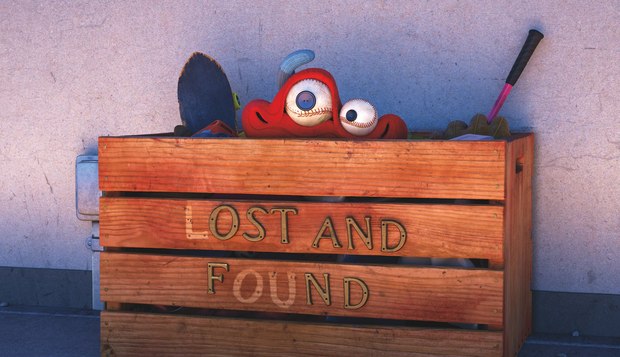Schoolyard bully learns that giving is more rewarding than taking in Pixar’s heartwarming Academy shortlisted animated short film.
Pixar Animation Studios’ animated short Lou, directed by Dave Mullins and produced by Dana Murray, recently made the Academy of Motion Picture Arts and Sciences shortlist for best animated short film. The heartwarming film tells the story of a schoolyard bully, who learns a lesson from an invisible creature that lives in the school’s lost and found box.
The short film opened in front of Cars 3 this summer. Mullins, who joined Pixar in 2000, has worked on such films as Monsters Inc., The Incredibles, Ratatouille, and Cars 1 & 2 as well as serving as directing animator on Academy Award-winner Up. He also contributed his animation skills to Brave, Inside Out and The Good Dinosaur.

Dave Mullins
Mullins explained that Pixar artists are encouraged to pitch ideas for animated short films, so he’s made a few pitches over the years, but this one really struck a chord. He first pitched Lou in 2012.
He explained that the film was inspired by experiences he had as a child. “I moved around a lot when I was a kid, and I just started thinking about how awkward you are, when you’re a kid, especially if you’re a new kid at the school, and how, at times, I would just want to be invisible. So, I thought, well, wouldn’t it be cool to come up with a character that could hide at a school, and be invisible.”
So originally, the idea was a for an invisible kid running around the school yard, stealing toys from the other kids. When he finally befriends a young girl, he decides to give back all the toys.
“John Lasseter looked at that and he said, ‘This is really cool, but, I hate the fact that there’s a little kid underneath,’” says the director.
So he went back to the drawing board and finally struck on the idea of the invisible creature being an anthropomorphized collection of items from the Lost & Found box. “And then, the bully that just wanted attention, ended up being JJ’s character,” explains Mullins. “He’s sort of a bully, but he’s really just awkward. He doesn’t know how to play with other kids, so those two ideas basically separated apart. And the second time I pitched it, about six months later in 2013, that’s when it got greenlit.”
In terms of the film’s overall look, Mullins explained that “Shorts are a great time to experiment with looks and try different things, but for me it was a little less about that. I actually felt that the look of the Toy Story world, which is a similar caricature world, fit really well, because of what I wanted to accomplish with Lou, which was this pile of cloth and toys, and springs, and all this stuff. And to animate that, I knew that I was going to have to use some of the resources from around the studio.” He added that he was looking more to Toy Story 3 than Toy Story 1 for that kind of stylistic inspiration.
“So I wasn’t really interested in coming up with a completely new look,” he says. “I was interested in coming up with a completely new character that moved like something we’ve never seen before, and he can change shape.”
Mullins explains that he worked closely with production designer Albert Lozano and Tony Fucile developing the two main characters -- Lou and JJ. “I just really connect with their design sensibilities and they were just great partners on the show,” he says. I wanted something that felt realistic enough that it looks really incredible when it comes together but it’s actually caricatured enough to actually be funny.”
The character of Lou comes together from a collection of items in the lost and found bin -- starting with a hoodie for a torso, with baseballs for eyes, a slinky for an arm and a baseball glove for a hand.
Mullins explained the he got to test out some of the techniques that were being developed for Pixar’s Coco. “First the biggest thing was the cloth because we had a character that was made out of this hoodie. They were using a hoodie a lot on Coco. We wanted to test what we could do with cloth, where we animate it by hand, but then is gets simulated on top of that.”
He explained that supervising animator Evan Bonifacio was able to animate shots with Lou and then hand them over to Henry Garcia who oversaw cloth and simulation. “What I wanted to do was treat animation and simulation as one department basically,” says Mullins.
“But then, when we would get it back, we could tweak the animation with the simulation staying intact,” says Mullins. “It was sort of a new thing that we are doing at the studio and for us, it worked out great because we didn’t have to constantly resend everything back and forth. And so, I would say we’re really pushing that envelope with Lou.”
Mullins hopes that audiences take away the central lesson from the film -- that giving can be so much more fulfilling than taking away.
“Bullies are usually just acting out because they’re awkward or young and don’t have their moral compass set. In a weird way, they sometimes feel invisible, too,” Mullins says. “If you can find out what their motivations are, maybe you can solve some things. That’s what I like about Lou: True happiness comes from giving. Lou gets J.J. to understand that.”
The director is now hard at work as a directing animator on Incredibles 2, which is due in theaters next June.
Scott Lehane is a Toronto-based journalist who has covered the film and TV industry for 30 years. He recently launched VRNation.tv -- an online community for VR enthusiasts.










